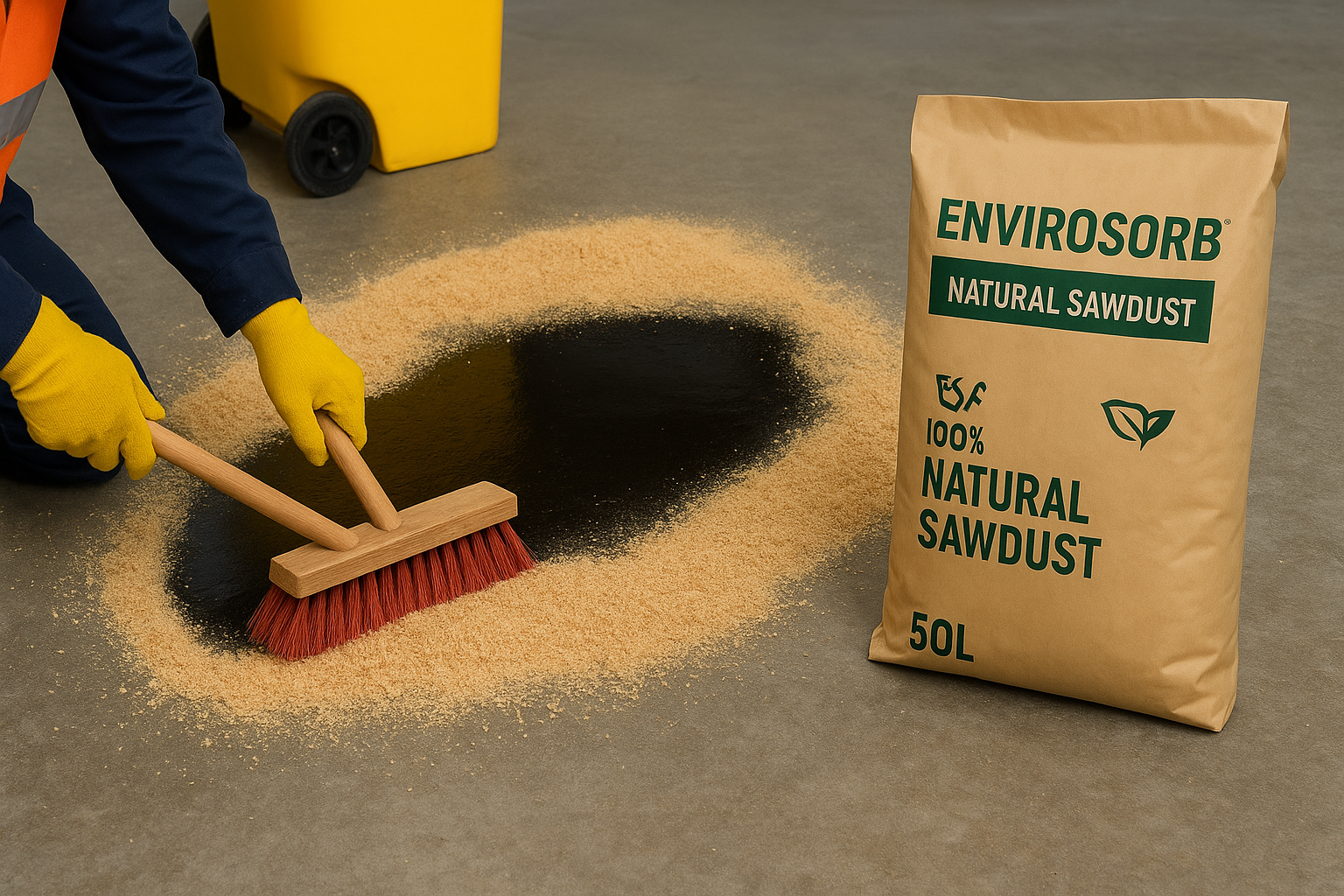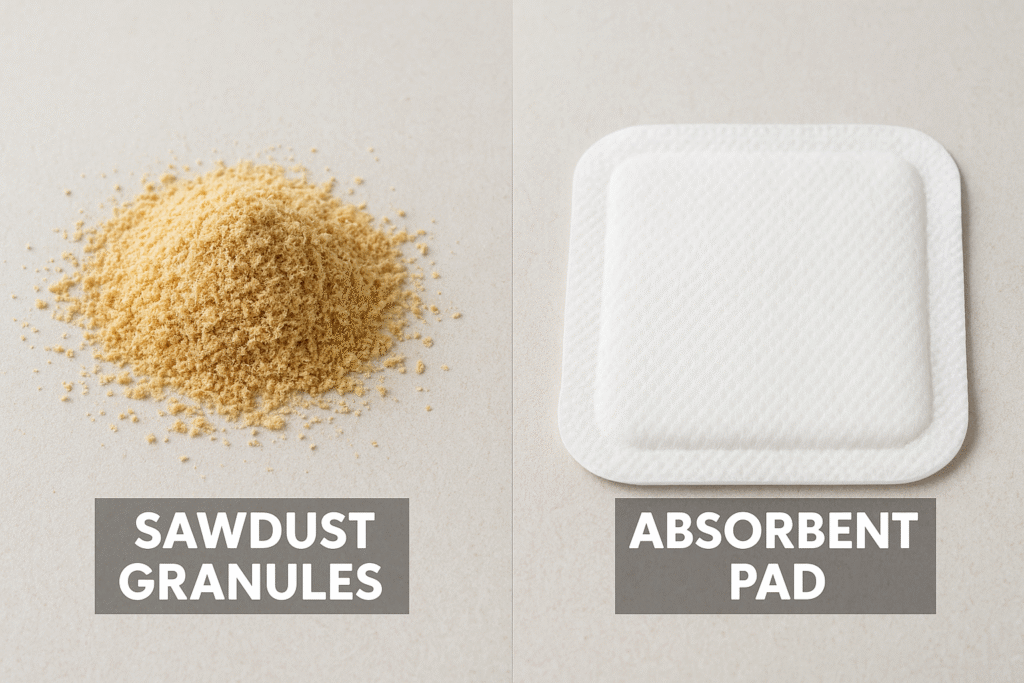
When an oil or chemical spill strikes, quick action is everything. Slippery floors, workplace hazards, and environmental risks can escalate in minutes. While high-tech cleanup tools exist, some of the most effective solutions are also the simplest: sawdust and granular absorbents.
These natural, lightweight and eco-friendly materials have quietly been the unsung heroes of spill control in industries worldwide. Let’s explore why.
What Are Granular Absorbents?
Granular absorbents are small, loose particles designed to soak up and trap liquids, preventing spills from spreading. Unlike absorbent pads, they encapsulate the liquid making them a staple in industrial and automotive cleanup.
They are commonly used in:
- Workshops & warehouses
- Service stations & garages
- Manufacturing plants
- Environmental cleanups
From oil and fuel to chemicals and wastewater, granular absorbents offer a reliable first line of defense against workplace spills.
Types of Granular Absorbents
Choosing the right absorbent can make all the difference in safety and cleanup efficiency.
- Clay-Based Absorbents: Affordable but heavy; not the most eco-friendly option.
- Silica-Based Absorbents: Effective but carry OSHA warnings for dust inhalation.
- Cellulose-Based Absorbents: Made from recycled fibers; eco-friendly and biodegradable.
- Peat Moss: Selectively absorbs oil, repels water; perfect for marine oil spill cleanup.
- Polymer-Based Absorbents: Advanced technology that gels liquids for easy disposal.
👉 The right choice depends on the type of liquid, spill volume, and workplace requirements.

Sawdust: More Than Just “Dust”
When people think of saw dust, they picture a messy byproduct of woodworking. But in reality, sawdust is one of nature’s most effective oil absorbent powders.
Why Sawdust Works:
✅ Its fine, porous structure soaks up liquids quickly.
✅ Lightweight, easy to apply, and simple to sweep up.
✅ Biodegradable and eco-friendly absorbent.
Everyday Uses of Sawdust:
- Industrial Spill Cleanup: Soaks up oil, fuel, and chemical leaks.
- Agriculture & Gardening: Improves soil texture and composting.
- Animal Bedding: Soft and absorbent for livestock.
- Biomass Fuel: Used in eco-friendly energy production.
- DIY & Crafts: Adds texture to paints and eco-projects.
Clearly, sawdust is not waste, it’s a sustainable resource with wide-ranging uses.
Product Spotlight: Envirosorb Natural Sawdust
One standout product is the Envirosorb Natural Sawdust an eco-friendly absorbent trusted across industries.
Key Benefits:
✅ Made from 100% natural pine timber.
✅ Absorbs up to 10 liters of water per kg.
✅ Lightweight, safe, and easy to handle.
✅ Leaves surfaces dry, clean, and slip-free.
✅ Natural woody scent with zero harsh chemicals.
✅ Unlimited shelf life if stored correctly.
Industries Using Envirosorb Saw Dust:
- Mining and construction sites
- Automotive workshops
- Warehouses and logistics hubs
- Service stations
- Sewage and wastewater treatment plants
How to Use It:
👉 Sprinkle sawdust over the spill.
👉 Sweep back and forth with a stiff broom until absorbed.
👉 Collect used material with a dustpan.
👉 Dispose responsibly as per local waste guidelines.
With Envirosorb Saw Dust, companies get the best of both worlds powerful spill cleanup + environmental responsibility.
Why Sawdust & Granules Are the Future of Spill Management
As industries move toward sustainability and safety, the demand for natural and biodegradable absorbents is rising. Sawdust and eco-friendly granules provide:
- Cost-effective spill cleanup
- Reduced environmental impact
- Safer workplaces
Whether you call it sawdust, saw dust or natural oil absorbent powder, this simple material continues to prove itself as a reliable, green solution for modern industries.
FAQs About Sawdust & Granular Absorbents
1. Can sawdust really absorb oil?
Yes! Sawdust is highly porous, making it effective at soaking up oil, fuel, and chemical spills. It’s lightweight, natural, and easy to sweep away after use.
2. Is saw dust safe for the environment?
Absolutely. Sawdust is biodegradable, non-toxic, and eco-friendly, unlike synthetic absorbents that may harm the environment.
3. What is the difference between sawdust and other granular absorbents?
Sawdust is a natural absorbent made from timber, whereas other granules may be clay, silica, or polymer-based. Sawdust stands out because it’s lightweight, safe, and sustainable.
4. Can I reuse sawdust after cleaning a spill?
No, used sawdust that has absorbed oil or chemicals should not be reused. It should be collected and disposed of properly as per local waste regulations.
5. What industries benefit the most from saw dust absorbents?
Industries like automotive, mining, manufacturing, warehousing and wastewater management use saw dust for efficient spill cleanup.
6. How does saw dust compare to absorbent pads?
Pads are quick for small spills, but saw dust is often more cost-effective and versatile for larger or irregular spills, especially in industrial settings.
7. Where can I buy eco-friendly sawdust absorbents?
You can check out products like Envirosorb Natural Sawdust, which is widely used for industrial spill control.
Final Thoughts
From small garage leaks to large-scale industrial accidents, sawdust and granular absorbents remain the most practical, affordable and eco-friendly tools for spill control.
And with products like Envirosorb Natural Saw Dust, businesses don’t just clean spills, they make a conscious choice for safety and sustainability.
So next time you see a bag of saw dust, remember: it’s not just waste, it’s an eco-warrior for spill control.

